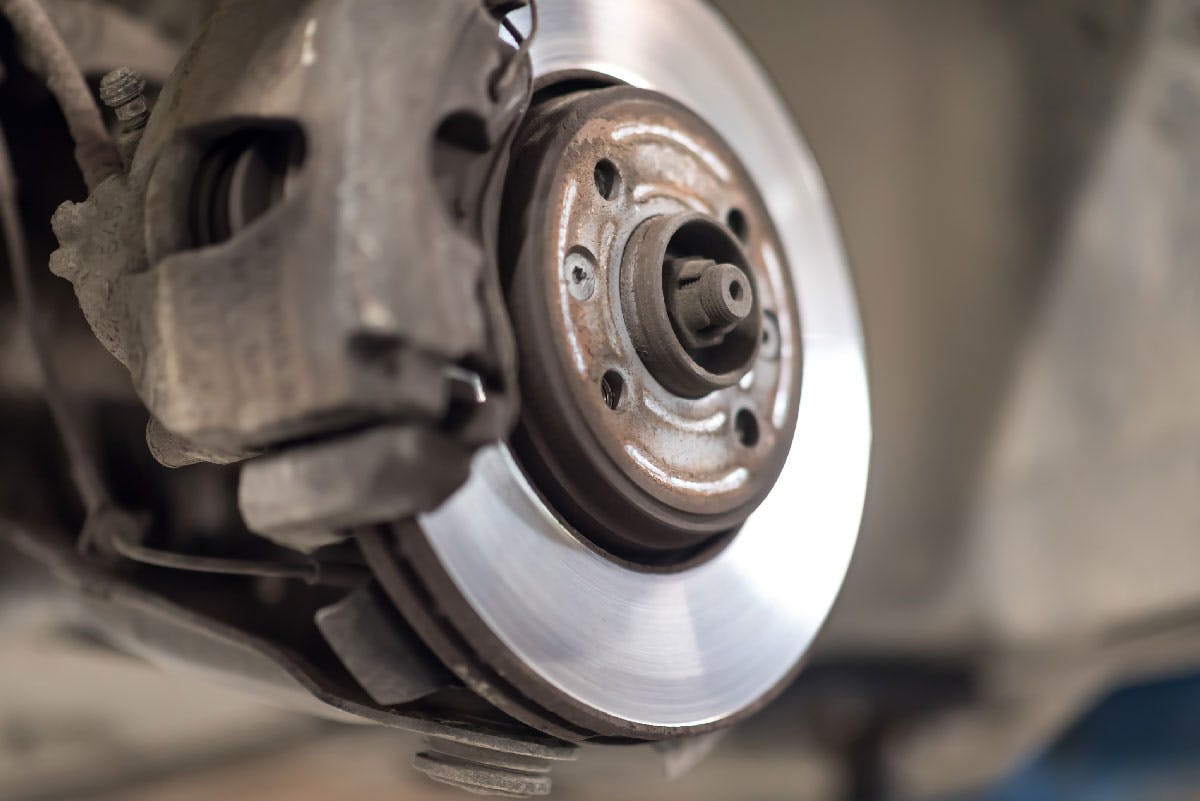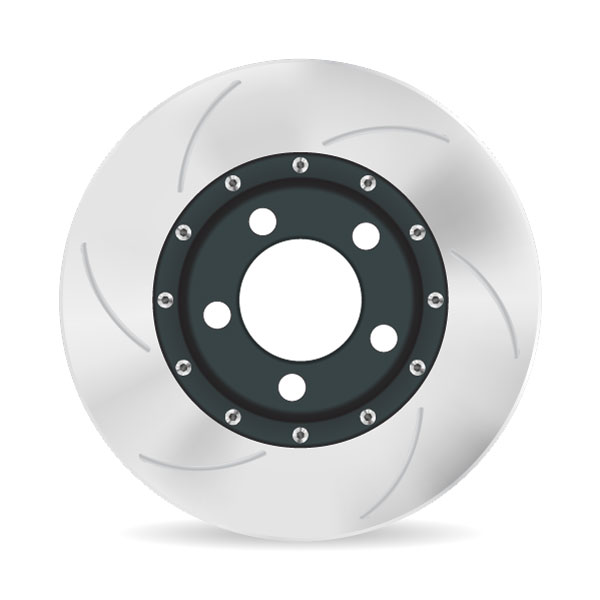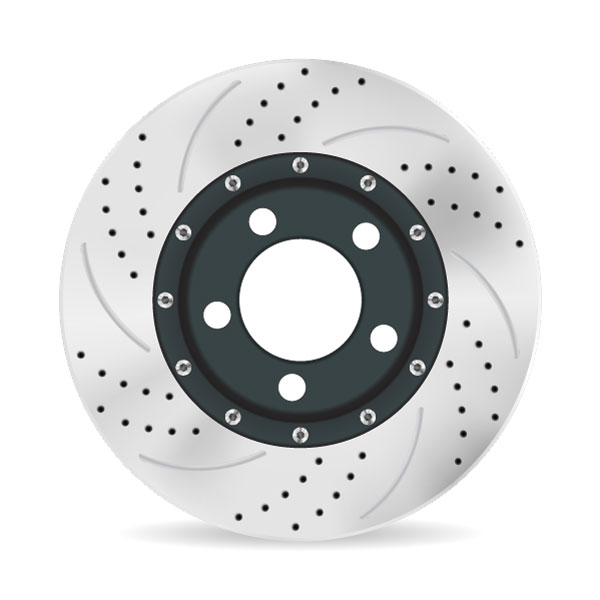If you are like most American drivers, you will apply your brakes around 200 times a day. That is 200 times you entrust your safety to 40+ components to bring you to a stop. Some of the main components in the stopping effectiveness of your vehicle are your rotors, which work to dissipate the heat created by your brake pads.
Key Takeaways:
|
Table of Contents
- What are Brake Rotors?
- What are the Different Types of Brake Rotors?
- When do you need to Replace your Rotors?
- How much do Brake Rotors Cost?
What Are Brake Rotors?
Brake rotors are circular discs connected to each wheel (two in the front and two in the back). Rotors are designed to turn motion (kinetic energy) into thermal energy (heat).
When you press down on the brake pedal, it sends a signal via the master brake cylinder to your calipers to squeeze your brake pads together against the rotors’ large surface area. This friction created by the pads pressing up against the rotors resists the wheel's spin, which slows its rotation and halts the car's movement.
What Are The Different Types of Brake Rotors?
When the time comes to replace your rotors, remember that not all rotors are made the same.
In fact, there are four different types to choose from, so before replacing your vehicle's rotors, make sure you're selecting the right one for your needs.
The four different rotor types are:
- Blank & Smooth - Blank and smooth rotors are what you'll find on most passenger vehicles and feature a smooth, blank metal surface around the rotor
- Drilled - Drilled rotors feature drilled holes around the metal surface
- Slotted - Slotted rotors feature long "slots" or lines in the metal surface
- Drilled & Slotted - Drilled and slotted rotors combine the drilled holes and slots for enhanced performance
Luckily, choosing the right rotor for your vehicle is as simple as viewing the existing rotors on your vehicle.
Another thing to keep in mind when replacing your vehicle's rotors is that the rotors on your family sedan will only work on your pickup truck and vice versa.
Now, let's look at the different rotors, what they look like, and their respective applications.
Blank & Smooth (Original Equipment-Specific)
Blank and smooth rotors are what you'll commonly find on most new passenger vehicles. Keep in mind that oe-specific rotors have a basic and premium option, which all depends on how they're manufactured. Unless you're a super aggressive driver or you're driving a luxury vehicle, blank rotors are a great choice for your vehicle.
Basic oe-specific rotors are traditionally made from recycled steel and often don't perform as well as your original equipment manufacturer (OEM) rotors due to thicker internal fins, which in turn impact the cooling abilities of your rotors. If you will use premium ceramic brake pads with your new rotors, don't pair them with a basic set of rotors. Basic rotors will also reduce the life of your new pads, as they'll wear down quicker due to the increased heat.
Drilled Rotors
Drilled rotors have holes drilled throughout the surface. These holes allow water, dust, and heat to easily dissipate off the surface of the rotor. Drilled rotors are an excellent choice for drivers that live in wetter climates, as they'll help increase stopping power in wet, rainy conditions. If you're looking at drilled rotors for a performance vehicle, you'll want to stay away. Drilled rotors don't work well under high heat and can fail quickly in a race-type driving scenario.
Slotted Rotors
Slotted rotors feature slots around the exterior surface of the rotor. They're a great choice for heavy-duty trucks and SUVs, especially those that need improved stopping power when towing or hauling. The slots are designed to draw more air in between the pad and rotor surface, which improves cooling and heat dispersion.
They're also designed to help remove excess brake debris and pad glaze that can occur at higher temperatures. While they are more efficient in a few ways, they come with the downside of not lasting as long, which also affects the life of your pads.
Drilled & Slotted Rotors
Lastly, drilled and slotted rotors are primarily designed for performance vehicles, like sports cars, that need enhanced cooling and heat dispersion. This rotor was designed to improve braking at high speeds during racing or track days. Where there is friction, there is heat. Over time, the continual force and heat with off-road or track driving can sacrifice the integrity of your rotors.
To minimize the adverse effects of high-performance driving, drilled and slotted rotors have both tiny holes and small trenches etched into the surface, acting as gutters for water and heat.
While great at dissipating heat, these performance rotors also have some setbacks, the largest being durability. Because the material has been removed from the surface, the edges can wear away brake pads faster than traditional smooth surfaces. The removed material also decreases the heartiness of the rotor, making them more prone to cracks.
When Do You Need To Replace Your Rotors?
You should consider replacing your rotors when they wear out, which can be just as frequently as your brake pads with newer models. It's advisable to replace them while you replace your brake pads to ensure optimal braking performance and safety.
While brake rotors used to be designed to last through two or three brake pad replacements, newer models can wear out just as quickly as your brake pads.
Common indications that your brake pads are wearing out:
-
A grinding noise when braking
-
Pulsating or shaking while stopping
-
Grooves or ridges that you can feel on the surface of the rotor
-
Visibility rusted or thinned-out rotors
-
Decreased brake performance
Just like brake pads, brake rotors wear down a bit every time you apply the brakes. On average, rotors can last anywhere from 30,000 to 80,000 miles.
Brake Rotor's exact lifespan depends on a few different variables:
-
The quality and durability of the rotor
-
How efficiently the rotor dissipates heat
-
The type of brake pad used
-
Driving conditions (i.e. city vs. highway)
-
Climate and exposure to elements like road salt
-
How aggressively do you brake
Additional signs that you need brake service, which may or may not have to do with the rotors, include squeaking or squealing coming from the brakes, brake dust buildup, a brake system indicator light coming on, veering to one side when braking, or decreased brake performance that results in taking longer to stop. These symptoms might originate with your brake pads, brake fluid, master cylinder, or caliper.
If you notice anything unusual with your brakes, it’s safest to have them checked out by a mechanic as soon as possible.
Brake problems? Get a fast, upfront pricing estimate on mobile brake repair in your area.
How Much Do Brake Rotors Cost?
The rotors typically fall within $35 to $80 per unit. Labor costs for rotor and pad replacement average around $150 to $200 per axle, with the potential for lower fees when utilizing mobile brake repair services instead of a traditional brake shop.
The combined expense of brake pads and rotors generally ranges from $250 to $600 per axle.
The price variation can be attributed to several factors, including:
-
The type, make, and model of your vehicle
-
What’s included in the brake service package and accompanying warranty
-
Fluctuations in part and labor costs
-
Variations in taxes, surcharges, and shop fees
Below are the average estimated brake pad and rotor replacement costs from a few different authorities around the web. It can be assumed that these ranges are for vehicles commonly found on the road. Luxury and performance vehicles will usually see higher price tags on brake replacement.
|
Parts |
Labor |
Estimate Total Cost (per axle) |
|
|
AutoZone |
Pads: $35-$150 Rotors: $60-$210 |
Pads: $80-$120 Rotors: $150-$200 |
$250-$500 |
|
RepairPal |
Pads: $143-$164 Rotors: $168-$233 |
Pads: $87-$110 Rotors: $136-$171 |
$473-$534 |
|
Kelly Blue Book |
Pads: $96 - $113 Rotors: $110 - $217 |
Pads: $118 - $140 Rotors: $91 - $145 |
$282-$424 |
Additional repair costs* commonly associated with rotor replacement include:
- Brake fluid flush: $80-$120
- Brake caliper replacement: $166-$251 per caliper
- Brake line replacement: $156-$192
- Master cylinder replacement: $397-501
*Sources: repairpal.com and itstillruns.com
Are you looking for an affordable, convenient brake repair service?
At NuBrakes, we pride ourselves on transparency, convenience, and affordability. If you're experiencing issues like grinding with your brakes, it may be time to replace your rotors. Let our experienced mobile brake specialists provide an on-site inspection at your home, apartment, or office. Here's what you can expect with NuBrakes:
- Backed up by 15,000+ 5 Star Reviews from our Customers
- See a detailed pricing estimate before scheduling your repair
- Get an honest assessment of what needs to be replaced and what doesn't
- We install only premium brake parts from brands we trust for our vehicles
- Have the peace of mind that our 2-year/24,000-mile warranty backs your brakes
- Appointments available seven days a week
Get a free estimate on mobile brake repair, and let our technicians come to you>>





